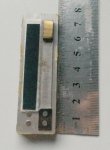Sebastian Bravo
Active member
Hi to everyone.
Months ago i started to learn Libertango by Astor Piazzolla. And now i can play it very well.
The chords in some part goes Am-G-F#-F-E (Not sure if some are seventh or diminished chords but anyways, the bass notes are the thing here) and it sounds bad in my accordion, because my lowest note is G. The transition to F# sounds weird because it is one octave higher than expected.
So, i decided to modify some reeds to get that low E bass, as i got another bass reed block from a Hohner Tango VM
I did some work on the low E reed (It was E2 checked by Datuner App) and the reed was flat metal (With no weigh on the top) so i put some Solder on it, and was a success. Then i did the same on the next higher E, that was E3, and i put solder on the top and got it down to E2.
<ATTACHMENT filename=IMG_20180223_045936_057.jpg index=0>
(It was on my instagram story)
First test, the reeds sound like this:
I tapped the chord reeds to hear just the new modified bass (They arent perfectly tuned but they seem to work) The low E1 delays 1 second (which i think is normal, but im trying to lower that delay)
The problem now is that the E3 note is missing. And it cant be on the chord section because the chords will sound different than usual with that E3 note playing.
So, i will need to make a new reed block. I was thinking in a winkelbass construction to fit 3 reeds to E3, F3 and F#3
What do you think, is it crazy enough? i know that buying a new accordion would be easier, but i really like this model and i want to modify it to give it more functions (I will also modify it to be a 96 bass, as i got the buttons from another hohner bass machine, with 12 buttons with free bass function, 6 of these are functional now: I need to drill the new holes)
Any suggestions and support will be helpful!
Months ago i started to learn Libertango by Astor Piazzolla. And now i can play it very well.
The chords in some part goes Am-G-F#-F-E (Not sure if some are seventh or diminished chords but anyways, the bass notes are the thing here) and it sounds bad in my accordion, because my lowest note is G. The transition to F# sounds weird because it is one octave higher than expected.
So, i decided to modify some reeds to get that low E bass, as i got another bass reed block from a Hohner Tango VM
I did some work on the low E reed (It was E2 checked by Datuner App) and the reed was flat metal (With no weigh on the top) so i put some Solder on it, and was a success. Then i did the same on the next higher E, that was E3, and i put solder on the top and got it down to E2.
<ATTACHMENT filename=IMG_20180223_045936_057.jpg index=0>
(It was on my instagram story)
First test, the reeds sound like this:
I tapped the chord reeds to hear just the new modified bass (They arent perfectly tuned but they seem to work) The low E1 delays 1 second (which i think is normal, but im trying to lower that delay)
The problem now is that the E3 note is missing. And it cant be on the chord section because the chords will sound different than usual with that E3 note playing.
So, i will need to make a new reed block. I was thinking in a winkelbass construction to fit 3 reeds to E3, F3 and F#3
What do you think, is it crazy enough? i know that buying a new accordion would be easier, but i really like this model and i want to modify it to give it more functions (I will also modify it to be a 96 bass, as i got the buttons from another hohner bass machine, with 12 buttons with free bass function, 6 of these are functional now: I need to drill the new holes)
Any suggestions and support will be helpful!










